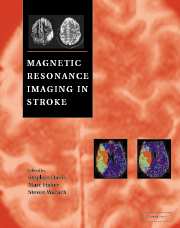Book contents
- Frontmatter
- Contents
- List of contributors
- Preface
- 1 The importance of specific diagnosis in stroke patient management
- 2 Limitations of current brain imaging modalities in stroke
- 3 Clinical efficacy of CT in acute cerebral ischemia
- 4 Computerized tomographic-based evaluation of cerebral blood flow
- 5 Technical introduction to MRI
- 6 Clinical use of standard MRI
- 7 MR angiography of the head and neck: basic principles and clinical applications
- 8 Stroke MRI in intracranial hemorrhage
- 9 Using diffusion-perfusion MRI in animal models for drug development
- 10 Localization of stroke syndromes using diffusion-weighted MR imaging (DWI)
- 11 MRI in transient ischemic attacks: clinical utility and insights into pathophysiology
- 12 Perfusion-weighted MRI in stroke
- 13 Perfusion imaging with arterial spin labelling
- 14 Clinical role of echoplanar MRI in stroke
- 15 The ischemic penumbra: the evolution of a concept
- 16 New MR techniques to select patients for thrombolysis in acute stroke
- 17 MRI as a tool in stroke drug development
- 18 Magnetic resonance spectroscopy in stroke
- 19 Functional MRI and stroke
- Index
- Plate Section
11 - MRI in transient ischemic attacks: clinical utility and insights into pathophysiology
Published online by Cambridge University Press: 26 August 2009
- Frontmatter
- Contents
- List of contributors
- Preface
- 1 The importance of specific diagnosis in stroke patient management
- 2 Limitations of current brain imaging modalities in stroke
- 3 Clinical efficacy of CT in acute cerebral ischemia
- 4 Computerized tomographic-based evaluation of cerebral blood flow
- 5 Technical introduction to MRI
- 6 Clinical use of standard MRI
- 7 MR angiography of the head and neck: basic principles and clinical applications
- 8 Stroke MRI in intracranial hemorrhage
- 9 Using diffusion-perfusion MRI in animal models for drug development
- 10 Localization of stroke syndromes using diffusion-weighted MR imaging (DWI)
- 11 MRI in transient ischemic attacks: clinical utility and insights into pathophysiology
- 12 Perfusion-weighted MRI in stroke
- 13 Perfusion imaging with arterial spin labelling
- 14 Clinical role of echoplanar MRI in stroke
- 15 The ischemic penumbra: the evolution of a concept
- 16 New MR techniques to select patients for thrombolysis in acute stroke
- 17 MRI as a tool in stroke drug development
- 18 Magnetic resonance spectroscopy in stroke
- 19 Functional MRI and stroke
- Index
- Plate Section
Summary
The brain responds dynamically to transient episodes of ischemic insult. Standard brain imaging techniques, computed tomography (CT) and conventional magnetic resonance imaging (MRI), are insensitive to dynamic and regionally varying neural parenchymal responses to tissue ischemia. In contrast, the novel MRI techniques of perfusion and diffusion imaging permit visualization of these critical tissue processes, and have afforded new insights into the physiopathology of human cerebral ischemia. In addition, clinical studies have demonstrated that magnetic resonance imaging is of substantial clinical utility in patients with transient ischemic attacks (TIAs).
Overview
The current conventional definition of transient ischemic attack is neurologic symptoms due to focal cerebral ischemia that resolve completely within 24 hours (Special Report from the National Institute of Neurological Disorders and Stroke, 1990). Defects of this definition, already apparent in the CT era, have been demonstrated even more pointedly by MRI investigations. We will consequently propose a new definition of TIA, informed by MRI findings, at the conclusion of this chapter. Nonetheless, all MRI studies to be reviewed in this chapter have employed this conventional definition.
Recent studies in animal models and in human patients with conventionally defined TIAs have identified three distinct tissue patterns on MRI, reflecting three somewhat dissimilar ischemic episodes that can underlie clinically similar TIAs. A very brief or low-intensity period of focal ischemia may disrupt synaptic transmission and produce transient neurologic deficits without causing early cytotoxic edema or permanent tissue injury.
Keywords
- Type
- Chapter
- Information
- Magnetic Resonance Imaging in Stroke , pp. 135 - 146Publisher: Cambridge University PressPrint publication year: 2003
- 2
- Cited by

